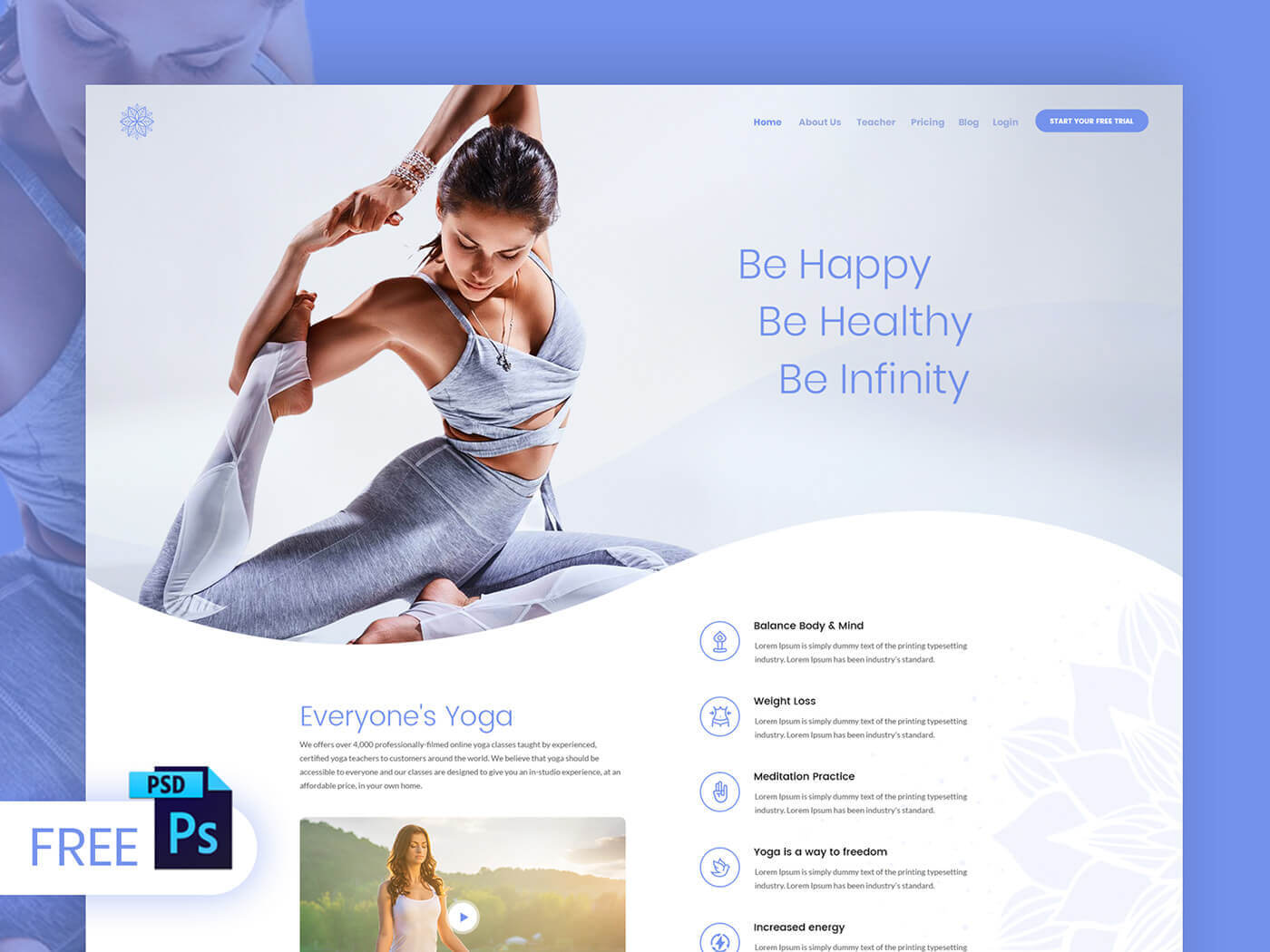Imagine having a yoga website that captivates your audience and inspires them to roll out their mats. You want a design that’s both calming and invigorating, one that reflects the essence of yoga itself.
With the right template, your website can become a serene haven for yoga enthusiasts, guiding them through your offerings with ease. The choices you make in designing your site can influence how visitors feel and interact, making it crucial to select a template that resonates with your message.
Dive into this article to discover the key elements of a perfect yoga website template and learn how they can elevate your online presence. Discover how to transform your digital space into a harmonious retreat that speaks directly to the hearts of your visitors.
Choosing The Right Template
Choosing the right template for your yoga website is crucial. It impacts user experience and engagement. A well-chosen template can enhance your site’s appeal and functionality.
Understanding Your Audience
Consider who visits your site. Think about their needs and preferences. A template should match their expectations. A calming design suits yoga’s peaceful nature. Incorporate soothing colors and serene imagery.
Design And Layout
Focus on simplicity and ease of navigation. A cluttered layout distracts users. Opt for clean lines and organized sections. A minimalist design keeps visitors engaged.
Mobile Responsiveness
Ensure the template is mobile-friendly. Many users browse on phones. A responsive design adapts to different screens. It improves accessibility and user satisfaction.
Customization Options
Look for templates with customization features. You might want to change colors or fonts. Customization allows brand personalization. It helps your website stand out.
Seo Compatibility
Choose a template with SEO-friendly features. It boosts your site’s visibility on search engines. Look for clean code and fast loading speeds. These elements enhance SEO performance.
Integration Capabilities
Check if the template supports plugins. Plugins add functionality to your site. Common integrations include booking systems. They are essential for yoga classes and appointments.
User Reviews And Ratings
Read user reviews before selecting a template. They provide insights into usability. Ratings reflect customer satisfaction. A highly-rated template often meets expectations.
Key Features To Look For
Choosing the right yoga website template is crucial for success. A well-designed template attracts visitors and keeps them engaged. Several key features can enhance the user experience and improve site performance. These features contribute to a seamless and enjoyable experience for both visitors and administrators.
Responsive Design
A responsive design ensures your site looks great on any device. Visitors use phones, tablets, and desktops to access websites. Your template must adapt to different screen sizes. This flexibility helps in retaining visitors and reducing bounce rates. Modern users expect smooth navigation, regardless of their device.
User-friendly Navigation
Easy navigation is a key factor in user satisfaction. Your yoga website template should offer clear menus and intuitive browsing. Visitors must find information quickly without confusion. Organise content logically and use descriptive labels. This approach helps users locate classes, schedules, and contact information easily.
Seo Optimization
SEO optimization is essential for visibility in search results. A well-optimized template improves your site’s ranking on search engines. It should include clean code and support for meta tags. Fast loading times and mobile-friendly features also contribute to better SEO. High visibility leads to more traffic and potential students.
Integration With Social Media
Social media integration expands your reach and engagement. Your template should allow easy sharing and connection with social platforms. Features like social media buttons enable users to share content. Engage with your community and attract new followers. This integration helps in building a strong online presence.
Showcasing Yoga Classes
Yoga is more than just poses; it’s a journey of self-discovery. A well-designed yoga website template can beautifully showcase your classes. It helps potential students understand your offerings and engage with your community. Highlighting class schedules, instructor profiles, and booking options is crucial.
Class Schedules
Clear class schedules attract students. Display days and times prominently. Use a calendar layout for easy navigation. Include different class types, like beginner or advanced. Make it simple to find the right class.
Instructor Profiles
Introduce your instructors with detailed profiles. Share their experience and teaching style. Include a friendly photo and short bio. Let students connect with instructors before joining a class. This builds trust and excitement.
Booking And Registration
Streamline the booking process. Offer online registration for convenience. Use forms that are easy to fill out. Provide clear payment options. Ensure the process is quick and secure. A smooth experience encourages new sign-ups.
Enhancing Visual Appeal
Yoga website templates enhance visual appeal with serene designs. They use calming colors and clean layouts, creating a peaceful online experience. These templates help visitors feel relaxed and connected, encouraging exploration and engagement with yoga content.
Yoga is not just a practice; it’s an experience that nourishes the mind, body, and soul. The visual appeal of your yoga website can either invite visitors to explore deeper or leave them unmoved. Enhancing this visual appeal is crucial for attracting and retaining users. Your website should embody the serenity and vitality that yoga represents.
High-quality Images
Imagine browsing a yoga site only to be greeted by blurry or uninspiring images. It’s a quick turn-off, right? High-quality images serve as the gateway to your yoga world. They should reflect the essence of yoga — peaceful, engaging, and energetic. Consider using images of serene landscapes, yoga poses, and tranquil spaces. These visuals can immediately draw a visitor in, making them feel connected to the practice. Do you have personal snapshots from a yoga retreat or session? Use them! Authentic images resonate more deeply.
Color Schemes
Colors speak volumes. A well-chosen color scheme can evoke the calmness and balance that yoga promotes. Opt for soft, earthy tones like greens, blues, and browns. These colors are soothing and can create a welcoming atmosphere. You might remember walking into a yoga studio painted in calming hues, instantly making you feel at ease. Your website can evoke the same feeling. Think about the emotions you want your visitors to experience and choose colors that complement those feelings.
Typography Choices
Typography can significantly influence the readability and aesthetics of your site. Choose fonts that are both legible and visually appealing. Sans-serif fonts are clean and modern, perfect for conveying a clear message. Avoid overly decorative fonts that might distract or make the text hard to read. Imagine browsing a site where the text feels like a dance of letters — that’s not the experience you want to offer. Aim for simplicity and clarity. You want your visitors to feel relaxed, not strained when reading. Quick Tips to Enhance Visual Appeal: – Use natural light in images to enhance authenticity. – Test color schemes with friends or colleagues to gauge emotional impact. – Keep the font size large enough for easy reading, especially on mobile devices. Think about your favorite yoga websites. What visual elements keep you coming back? Reflect on this as you design your own. Remember, your website is the first impression of your yoga offering. Make it count!
Incorporating Multimedia
Incorporating multimedia into your yoga website template enhances user experience. It makes the content interactive and engaging. Multimedia brings life to static pages. It captivates visitors and holds their attention longer. Use videos, audio guides, and tutorials to enrich your site. This approach improves learning and retention. Let’s explore how different multimedia elements can be integrated effectively.
Videos And Tutorials
Videos provide a visual guide for yoga poses. They help learners follow along easily. Tutorials break down complex moves step-by-step. This aids in understanding the nuances of each pose. Embed high-quality videos directly on the website. This ensures seamless playback without redirects. Keep videos concise to maintain interest. Show variations for beginners and advanced practitioners. This inclusivity caters to diverse skill levels.
Audio Guides
Audio guides offer a unique way to practice yoga. They allow users to focus on voice instructions. This minimizes screen distractions during sessions. Include calming background music for relaxation. This enhances the overall experience. Offer downloadable audio files for offline practice. Make sure the audio quality is clear and soothing. This ensures the instructions are easy to follow.
Building An Engaging Blog
Crafting a yoga website template involves creating a harmonious design. Focus on calming colors and intuitive navigation. Highlight essential sections like class schedules, instructor bios, and wellness tips.
Creating an engaging blog on your yoga website is an excellent way to connect with your audience and build a community. A well-maintained blog can enhance your site’s value by offering insights, tips, and inspiration. This not only keeps your visitors returning but also boosts your site’s search engine ranking.
Content Ideas
Crafting compelling content is essential. Think about the questions your audience might have about yoga. Are they beginners looking for basic poses, or advanced practitioners seeking new challenges? Consider writing about the benefits of yoga for mental health. Share personal stories about how yoga has impacted your life. This can make your content relatable and authentic. You might also want to explore current trends in yoga. Are there new styles or techniques gaining popularity? Discussing these can position your blog as a go-to resource for yoga enthusiasts.
Guest Contributions
Inviting guest contributors can diversify your blog’s content and bring fresh perspectives. Collaborate with yoga instructors, wellness coaches, or even enthusiastic practitioners. Guest posts can introduce your readers to new ideas and experiences. This can enhance the depth and breadth of your blog. When reaching out to potential contributors, highlight the benefits for them too. Mention how guest blogging can expand their audience and showcase their expertise. Have you ever thought about the power of community? By involving others, you not only enrich your content but also strengthen your network within the yoga community. Creating a dynamic and engaging blog takes effort, but the rewards are well worth it. The conversations you spark and the community you build can have a lasting impact.
Creating A Community Space
Discover a perfect yoga website template for creating a welcoming community space online. Engage visitors with peaceful designs and easy navigation. Offer resources, class schedules, and forums that encourage connection and growth.
Creating a thriving community space on your yoga website fosters connection. It allows members to engage and share their experiences. A community space encourages interaction and builds a supportive network. This feature can transform your website into a hub of activity. It enhances the experience for every visitor.
Discussion Forums
Discussion forums offer a platform for users to connect. Members can discuss yoga practices and share tips. They can ask questions and seek advice from others. Forums create a sense of belonging. They invite users to participate actively. These forums also keep your website dynamic and engaging. Regular activity in forums boosts SEO by increasing site visits.
Member Testimonials
Member testimonials provide real-life stories and experiences. They offer authentic insights into your yoga community. Testimonials can inspire new members to join. They help build trust in your services. Reading about others’ journeys can motivate and encourage. It shows the positive impact of yoga on their lives. Testimonials also add personal touches to your website. They demonstrate the value of your community space.

Ensuring Easy Maintenance
A well-designed yoga website template simplifies maintenance tasks. Clear layout and organized sections ensure easy updates. This boosts user experience and keeps content fresh.
Ensuring easy maintenance for your yoga website template is crucial. It saves time and keeps your site running smoothly. A well-maintained site attracts more visitors. It enhances user experience and builds credibility. Let’s explore how to simplify maintenance.
Content Management Systems
A content management system (CMS) helps manage website content. It allows easy updates without needing coding skills. CMS platforms like WordPress offer user-friendly interfaces. They make editing and adding new content straightforward. A good CMS supports plugins and themes. It enhances functionality and customisation options. Choose a CMS that fits your needs and budget.
Regular Updates
Regular updates keep your yoga website secure and efficient. Update themes, plugins, and CMS regularly. This prevents security vulnerabilities and technical issues. Updating often ensures compatibility with new web standards. It improves site performance and user experience. Schedule updates to avoid disruptions. This ensures your site stays reliable and fast.
Frequently Asked Questions
What Features Should A Yoga Website Template Include?
A yoga website template should include features like class schedules, instructor profiles, testimonials, and a booking system. These elements help in attracting and retaining visitors. Integrating social media links and a blog can enhance engagement. A responsive design ensures accessibility across all devices, improving user experience.
How Can A Yoga Website Template Boost Engagement?
A well-designed yoga template boosts engagement through interactive elements like video tutorials and forums. User-friendly navigation encourages exploration. Incorporating SEO-friendly content attracts more visitors. Regular updates and newsletters keep your audience informed and engaged. Mobile optimization ensures accessibility, enhancing user interaction.
Why Choose A Responsive Yoga Website Template?
Choosing a responsive yoga website template ensures your site looks great on all devices. It improves user experience and accessibility. Google favors responsive sites, enhancing SEO rankings. With more users accessing content via mobile, responsiveness is crucial. It helps maintain your audience’s interest and engagement.
How Do I Customize A Yoga Website Template?
Customizing a yoga website template involves adjusting design elements to fit your brand. You can change colors, fonts, and images. Adding personalized content, like instructor bios and class descriptions, enhances uniqueness. Use SEO practices to optimize your site. Ensure the template supports easy customization for best results.
Conclusion
A yoga website template offers simplicity and ease for your online presence. It helps showcase your classes, events, and expertise effectively. Templates are easy to customize, fitting your brand’s unique style. They ensure a professional look without complex coding. Engage visitors with clean design and intuitive navigation.
A well-structured site can attract more yoga enthusiasts. Start building your online community today. A good template saves time and effort. Your yoga journey deserves a strong digital platform. Choose a template that resonates with your vision. Connect with your audience effortlessly.









